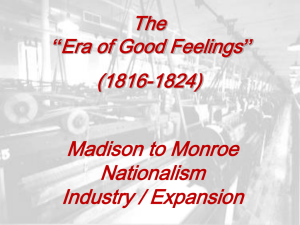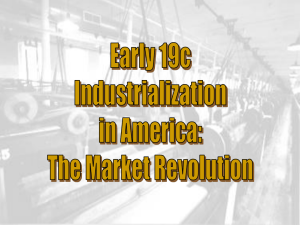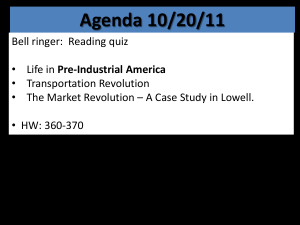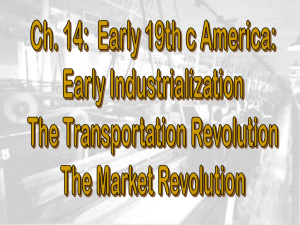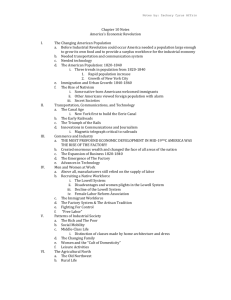early 19c Industrialization in America
advertisement
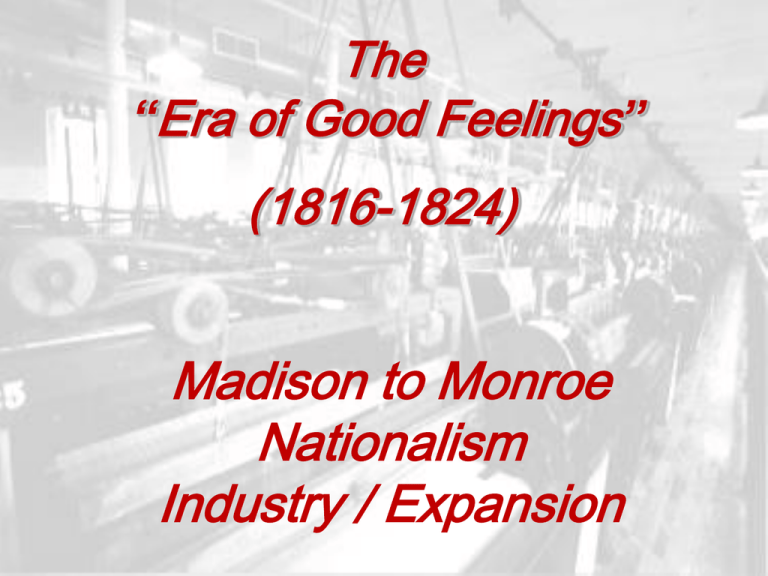
The “Era of Good Feelings” (1816-1824) Madison to Monroe Nationalism Industry / Expansion Regional Specialization NORTHEAST Industrial SOUTH Cotton & Slavery WEST The Nation’s “Breadbasket” ENTRY # 24 Make a Venn Diagram comparing the North Vs. the South with regard to: • What type of economy in each • Population #’s • Immigration • Urban development • Reliance on Cotton • Use of new Technology • Development of middle class • Literacy levels Regions grabbed the Inventions that best suited their economic pursuits ENTRY #25 As you watch the Film America the Story of Us: Division, fill in the cause effect diagram below: Industrial and Cultural/Social/Economic Changes Social Movements:? Transportation --- In the North:? Revolution Changes: In the South:? --- The American System (Economic Nationalism in Action) Protective Tariffs, starting with the Tariff of 1816 Second Bank of the U. S. Henry Clay, “The Great Compromiser” Internal improvements at federal expense. - National Road ENTRY # 26 What is a Revolution? Define in 2-3 sentences: Erie Canal, 1820s Begun in 1817; completed in 1825 Principal Canals in 1840 Robert Fulton & the Steamboat 1807: The Clermont First Turnpike- 1790 Lancaster, PA By 1832, nearly 2400 mi. of road connected most major cities. Cumberland (National Road), 1811 Conestoga Covered Wagons Conestoga Trail, 1820s The Railroad Revolution, 1850s Immigrant labor built the No. RRs. Slave labor built the So. RRs. Samuel F. B. Morse 1840 – Telegraph The Power Loom Patented by Edmund Cartwright in 1785 Eli Whitney’s Gun Factory Interchangeable Parts Rifle Resourcefulness & Experimentation Americans were willing to try anything. They were first copiers, then innovators. 1800 41 patents were approved. 1860 4,357 patents were approved. Samuel Slater (“Father of the Factory System”) New England Textile Centers: 1830s The Lowell/Waltham System: First Dual-Purpose Textile Plant Francis Cabot Lowell’s town - 1814 Lowell in 1850 •Factory workers were girls •Came from farms, leaving family •Housing was provided •Hard life, long hours, restricted living Lowell Girls What was their typical “profile?” New England Dominance in Textiles Elias Howe & Isaac Singer 1840s Sewing Machine U.S. Manufacturing Employment, 1820–1850 I’m a Factory Girl Filled with Wishes I'm a factory girl Everyday filled with fear From breathing in the poison air Wishing for windows! I'm a factory girl Tired from the 13 hours of work each day And we have such low pay Wishing for shorten work times! I'm a factory girl Never having enough time to eat Nor to rest my feet Wishing for more free time! I'm a factory girl Sick of all this harsh conditions Making me want to sign the petition! So do what I ask for because I am a factory girl And I'm hereby speaking for all the rest! Eli Whitney’s Cotton Gin, 1793 John Deere & the Steel Plow (1837) Most notable for making the West Farmable Cyrus McCormick & the Mechanical Reaper: 1831 Changing Occupation Distributions: 1820 - 1860 National Origin of Immigrants: 1820 - 1860 Why now? US Population Density 1810 1820 Map: Population Distribution, 1790 and 1850 The “American Dream” Americans regarded material advance as the natural fruit of American republicanism & proof of the country’s virtue and promise. A German visitor in the 1840s, Friedrich List, observed: Anything new is quickly introduced here, including all of the latest inventions. There is no clinging to old ways. The moment an American hears the word “invention,” he pricks up his ears. Distribution of Wealth During the American Revolution, 45% of all wealth in the top 10% of the population. 1845 Boston - top 4% owned over 65% of the wealth. 1860 Philadelphia - top 1% owned over 50% of the wealth. The gap between rich and poor was widening! The North Embraces Industry The tariff Congress placed on imported goods helped industry to flourish, particularly in the Northeast, where there were many factories and laborers to keep them running. Industrial Workers The arrival of industry changed the way many Americans worked by reducing the skill required for many jobs. This trend hurt highly skilled artisans, who could not compete with manufacturers working with many low-cost laborers. Southern Agricultural Economy and Society During the 1780s, Thomas Jefferson, James Madison, and George Washington hoped that slavery would gradually fade away. However, with the emergence of cotton as the South’s leading crop, slavery persisted. The Panic of 1819 CAUSES???
